Warning: pic heavy, as usual. 
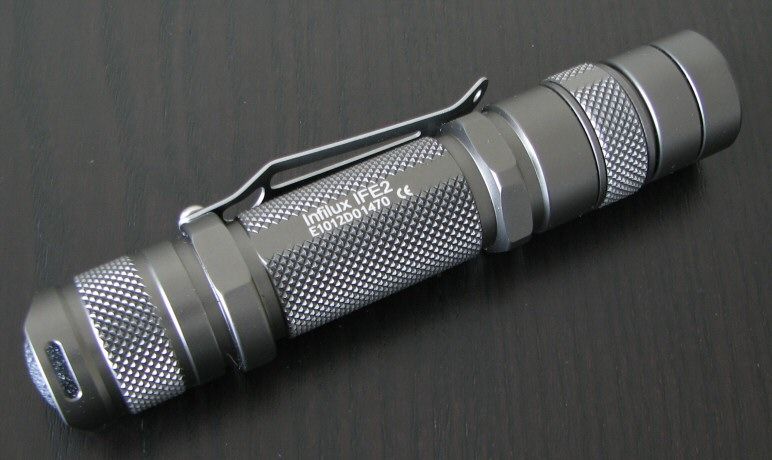
Manufacturer's Reported Specifications:

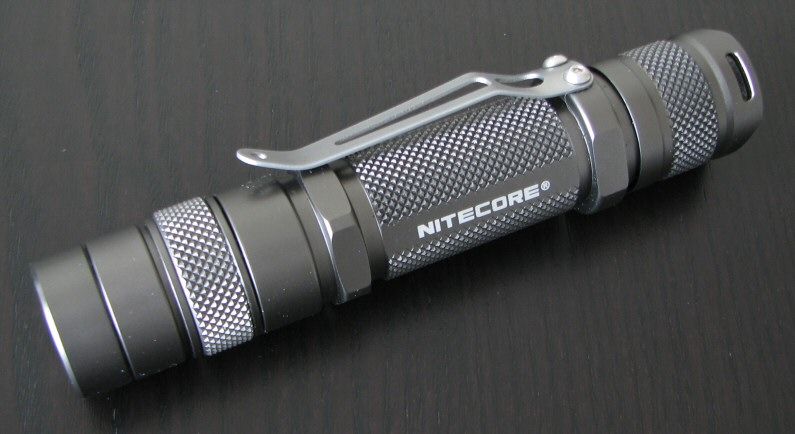
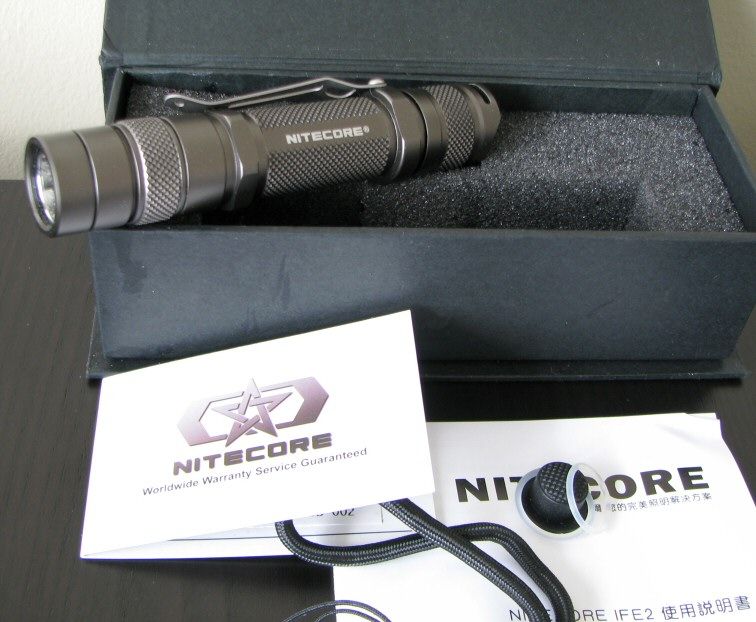
Packaging is fairly typical Nitecore. Inside the hard cardboard box with magnetic closing clasp is the light in cut-out foam, with a wrist strap, spare o-rings and boot cover, manual, and warranty card.
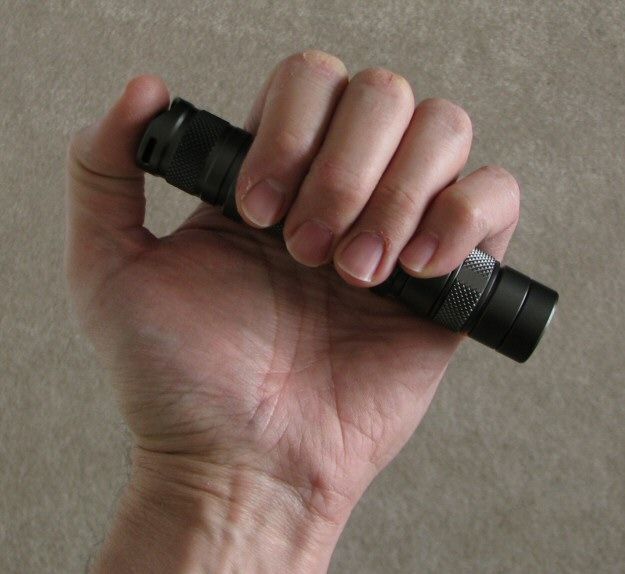
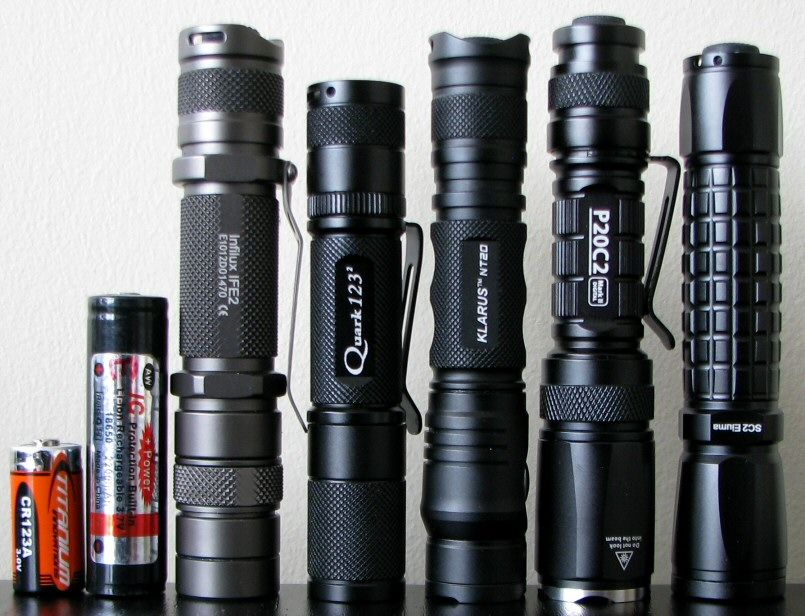
From left to right: CR123A, AW protected 18650, Nitecore IFE2, 4Sevens Quark 123-2, Klarus NT20, Eagletac P20C2-II, ITP SC2.
IFE2: Weight: 65.1g (no battery), Length 127.1mm x Width 23.6mm (bezel)
As you can see from the photo line-up, The IFE2 is quite small for this class of light. In fact, most of the other lights this small can't take protected 18650 cells (i.e. body diameter is too narrow). You are lucky if protected 17670 will fit – and often have to go down to 14670. I'm happy to report the IFE2 body takes all my protected 18650 cells. :thumbsup:
However, most of my recent high-capacity cells (even the button tops) wouldn't light up the IFE2. I believe this due to top of the cells not fitting into the head opening (which is slightly narrower than the body on my sample). Certainly, flat-tops or large button-tops won't work, as there is a raised disc around the positive contact surface in the head (see below).
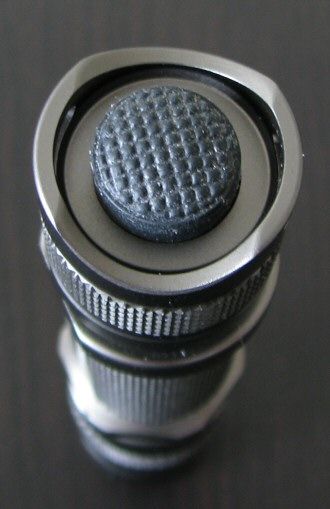
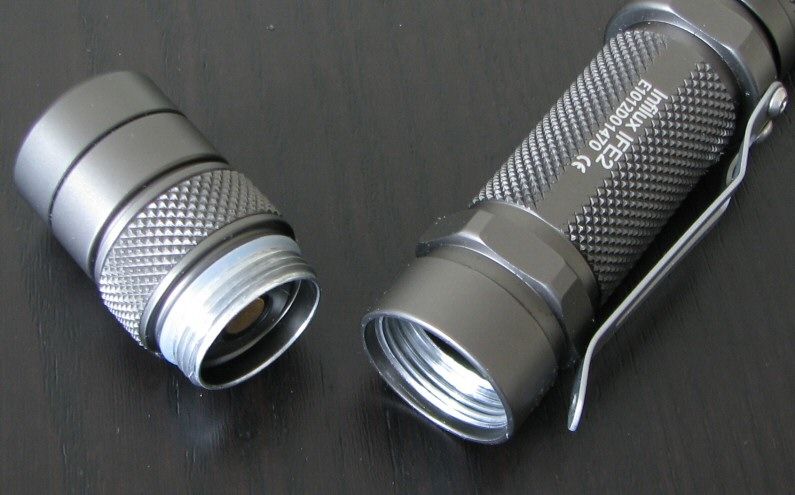
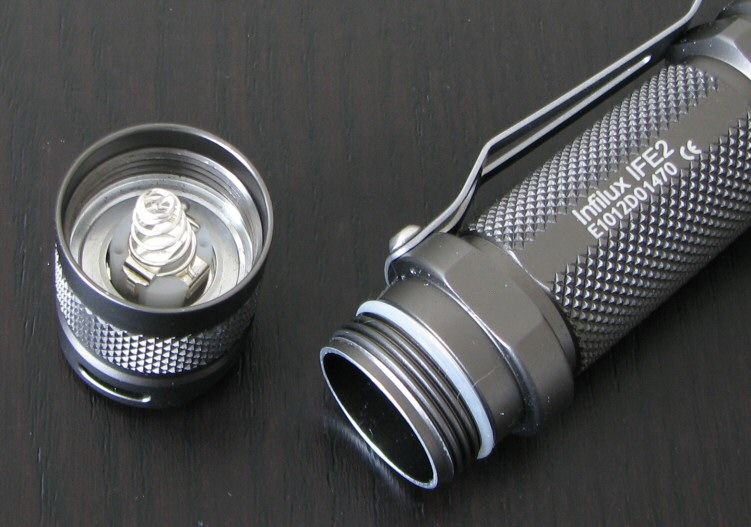
Tailcap threads are anodized for lock out. The light cannot tailstand. Knurling is not overly aggressive, but the number of body elements helps with grip. Clip is fairly basic, and held on with Allen screws.
Anodizing is excellent on my sample, no chips in the dark gray natural finish (HA = type III). The color is a departure for Nitecore - it looks almost silver-gray. Lettering is sharp and bright.
Switch is a forward clicky, with a slightly longer than typical traverse.
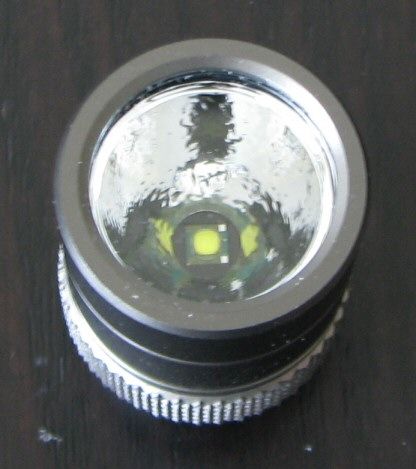
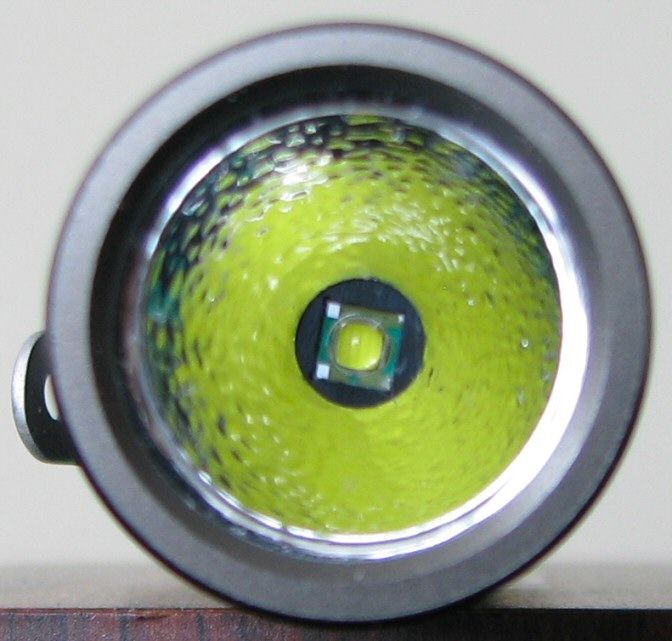
The IFE2 features the Cree XP-G R5 Cool White. The reflector is textured to what I would consider a medium orange peel (MOP). The head opening is not very large, so I would not expect much throw from the IFE2.
Which brings us to the requisite white wall hunting . All lights are on Hi on 18650 (AW Protected where available), about ~0.75 meter from a white wall (with the camera ~1.25 meters back from the wall). Automatic white balance on the camera, to minimize tint differences.
. All lights are on Hi on 18650 (AW Protected where available), about ~0.75 meter from a white wall (with the camera ~1.25 meters back from the wall). Automatic white balance on the camera, to minimize tint differences.
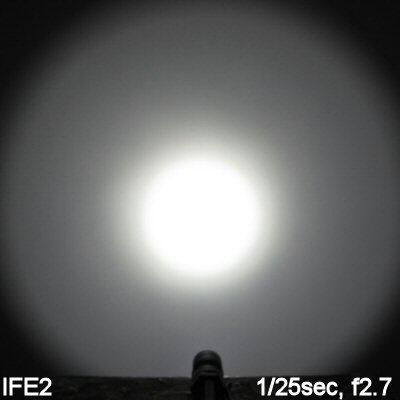
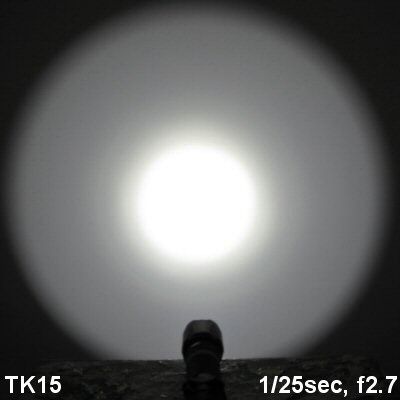
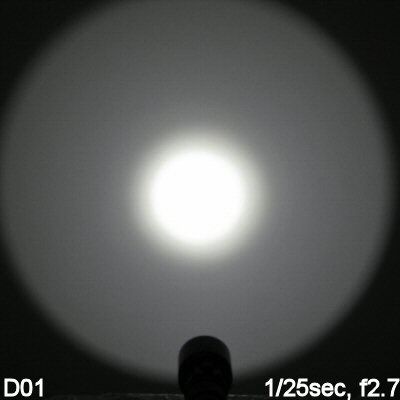
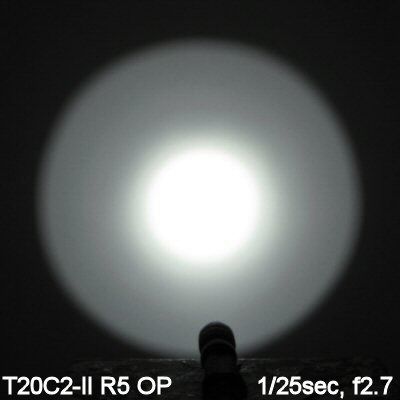
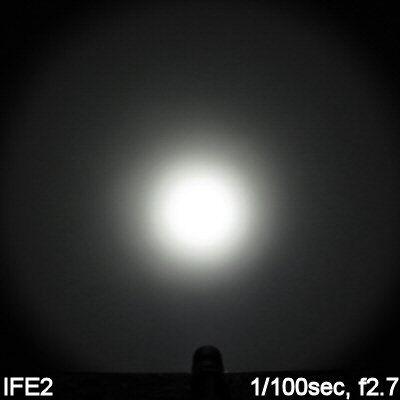
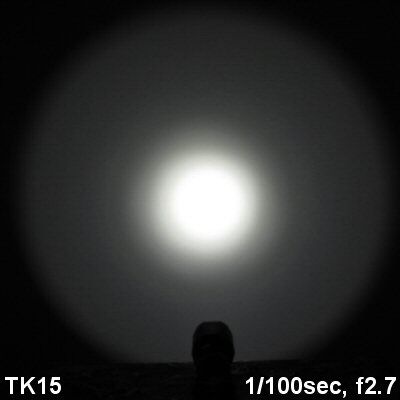
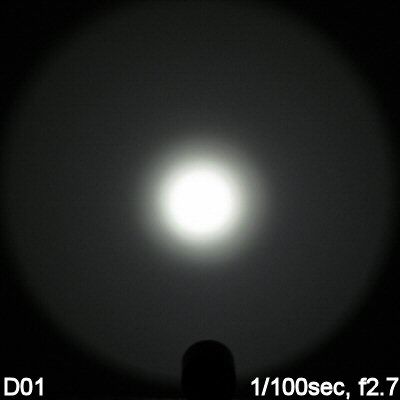
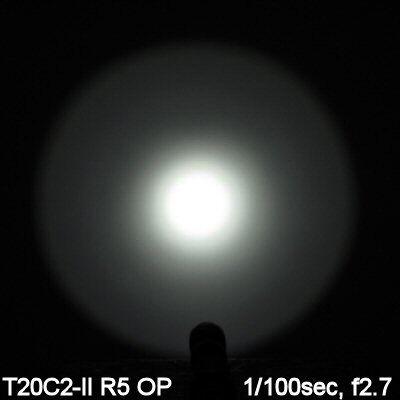
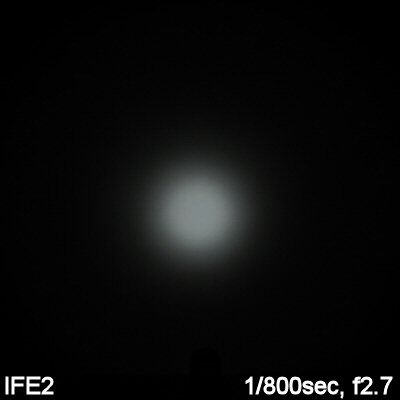
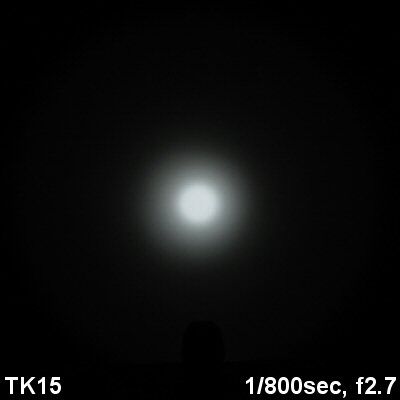
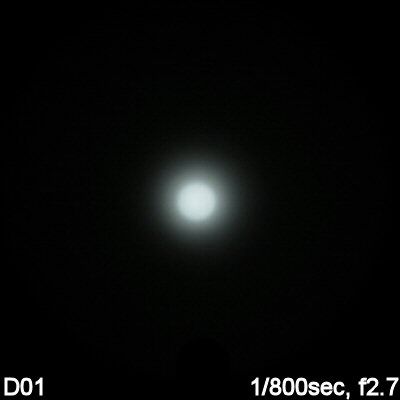
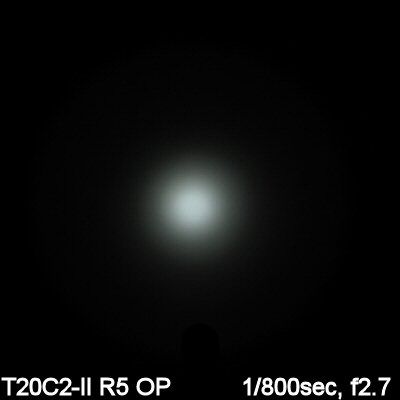
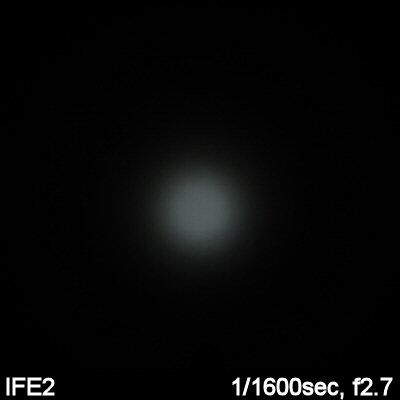
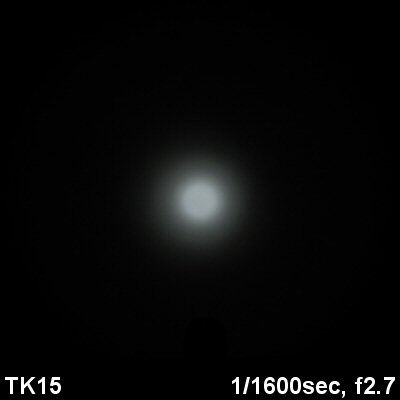
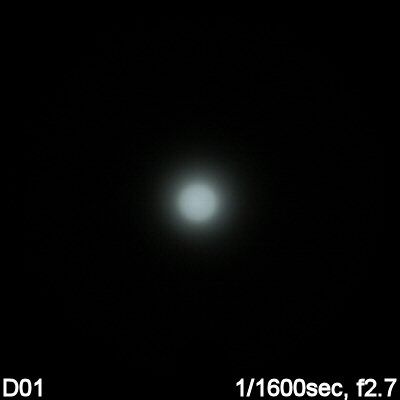
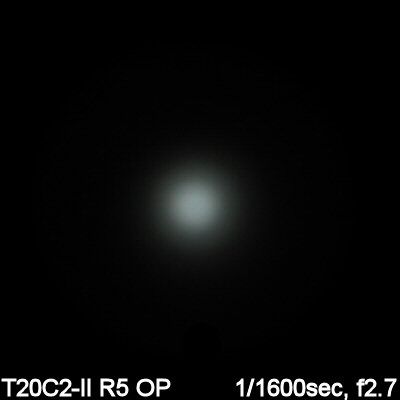
As you can see, the IFE2 is definitely not a thrower. I found the beam to have a pleasant transition from hotspot to spill. Scroll down to my Summary Tables for more specifics on output and throw.
User Interface
Turn the light on by the tailcap switch. Half-press the tailcap for momentary-on, click for locked-on
Mode switching is controlled by the magnetic control ring in the head. The IFE2 features a continuously-variable interface – you control the output level by twisting the ring. You can select your desired mode while the light is off.
The ring traverses a little over 2/3 of the circumference of the light. There is one clear and firm detent just below the minimum output, which is a standby mode. Interestingly, strobe is "hidden" just below this detent (i.e. turn the ring a little past the detent to activate strobe).
Ramping Pattern
EDIT: this section has been updated and revised from my initial post.
The big question is whether the output selection of the IFE2 is "visually linear". Generally, here on the forums, that has been taken to mean a logarithmic ramp as opposed to an actual linear ramp of outputs. The reason for this is that we perceive brightness in a non-linear way (actually, not just brightness - most of our sensory perceptions are non-linear). This is why twice the lumens doesn't appear twice as bright to us - lumens are an objective (linear) measure of output, and our subjective perceptions are not linear.
A logarithmic adjustment has long been used to adjust for our relative visual perceptions (e.g. the stops of camera are logarithmic). And like most here, up until now I have found that all continuously-variable lights with a logarithmic correction of output generally look "visually-linear". And then the IFE2 (and Sunwayman V10A, which shares a similar circuit) came along.
To start, here is what the IFE2 looks like in my lightbox. To measure this, I slowly turned the ring at as close to a constant rate as I could manage, over ~40 secs or so. My lightbox collected output readings every second, and I then plotted the relative lightbox output against the estimated degree shift of the ring (i.e. with 360 degrees being a complete turn). Note the ring turns a little over 2/3 the circumference of the light, or about ~280 degrees.
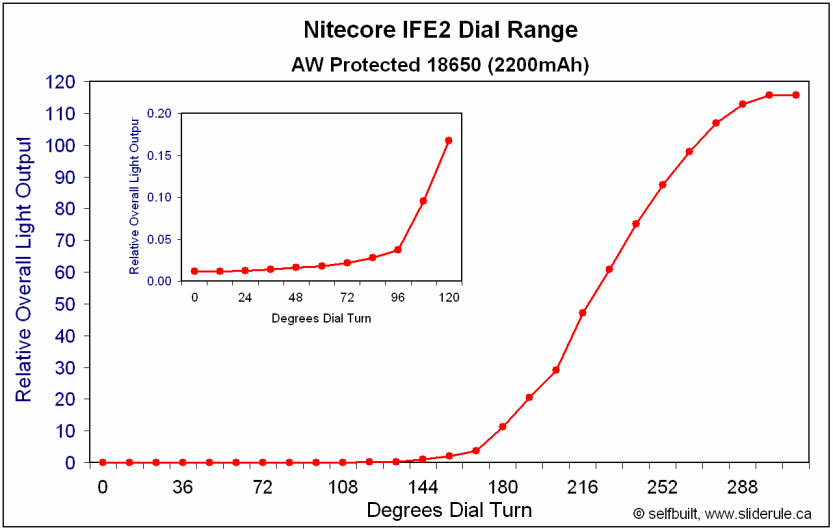
I have blown-up the first third of the ramp in the inset graph, to show you that output does indeed increase over the whole ring (albeit seemingly slowly at first). Now, you can certainly argue that the output trace looks like it could be logarithmic. Indeed, if you plot it on a log scale, you get something approximating a straight line. However, the IFE2 does NOT subjectively appear to me to be visually-linear when handling (e.g. it does indeed spend a lot of time at the very low outputs over the first third of the ring).
Upon reviewing the scientific literature, I see that relative power relationships have superseded simple logarithmic corrections for linearizing our sensory perceptions. For perceived brightness, the currently accepted linearization method is actually a cube root of output. For a full discussion of this - including detailed graphs and primary literature references - please see post #3 in my V10A review.
When plotting with a cube root transformation of my lightbox's output scale, you get the following graph:
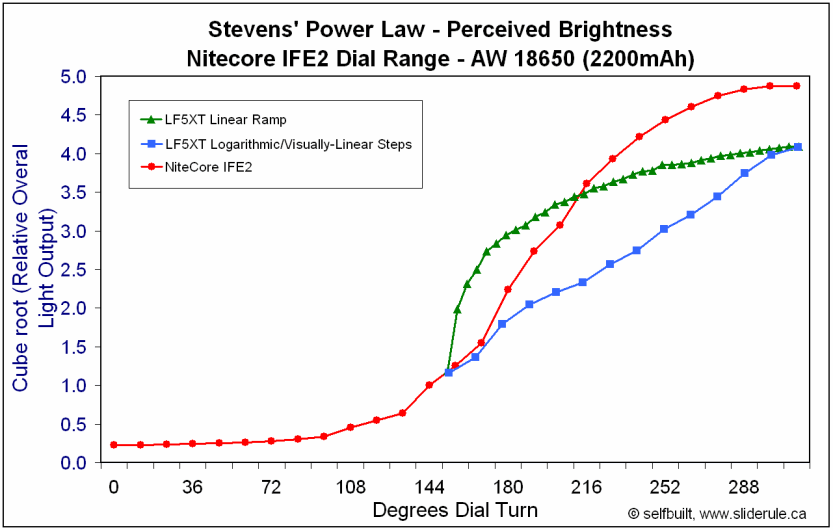
This graph MUCH better matches what I see by eye for the IFE2, compared to a logarithmic plot. :thumbsup: I have added the LiteFlux LF5XT (on 14500) to the graph, as it does both a linear ramp and a logarithmic step pattern. The linear and logarithmic ramps of the LF5XT also pretty closely match my relative perceptions.
The point to the above is to show that the IFE2 goes to much lower outputs than any other linear or logarithmic continuously-variable light I've seen before. It also betters matches what I subjectively see across the whole range of outputs on these lights. So for now on, I will also include this type of plot (along with standard linear plots) for all the continuously-variable lights I review.
All that aside, I actually consider this dynamic range control of the IFE2 to be superior to a purely "visually-linear" ramp across the whole range. The logarithmic correction allows you to exquisitely fine-tune your low output selection. :thumbsup: And once you get into brighter outputs, the proportional increase seems quite linear.
Intrepid readers may notice that the IFE2 has almost exactly the same pattern and low level as the Sunwayman V10A which I have recently reviewed. Please see that thread for a greater discussion of the relative ramping patterns.
One additional feature of the IFE2 is the "hidden" SOS mode. To access, cycle the light rapidly from bright to low, to bright, and back to low. Turn off/on to restore regular constant output control.
Current Draw
You would hope that this wide range of low modes translates into a range of super-long runtimes. Unfortunately, the circuit overhead for this level of control is considerable, and Nitecore estimates only one week of runtime at the lowest level.
I have measured the battery current draw at both the standby detent and at the lowest output level, and get 11mA on 1x18650 in both cases. For a standard capacity 2200mAh 18650, that would translate into 8.3 days (consistent with Nitecore's 1-week estimate). On 2xRCR (750mAh capacity), I measured 5mA, which would translate into just under a week.
PWM
I presume the light uses PWM for the variable outputs, but I was unable to detect the frequency with my setup (which means it must be in the high kHz range). It is certainly not detectable visually. :thumbsup:
At the highest output levels (i.e. over the last quarter turn of the ring), I was able to detect a weak signal in the 1.7-1.8 kHz range. This seems to be some sort of circuit artefact – it definitely isn't the PWM freq, as you could easily spot those levels with an oscillating fan.
Once again, that is remarkably similar to what I noticed on the Sunwayman V10A.
Strobe
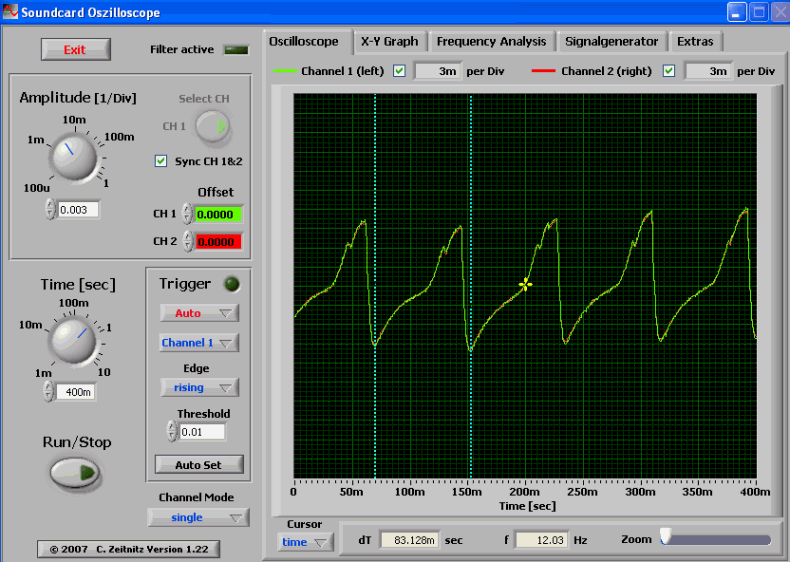
Measured at 12 Hz in my testing.
Testing Method:
All my output numbers are relative for my home-made light box setup, a la Quickbeam's flashlightreviews.com method. You can directly compare all my relative output values from different reviews - i.e. an output value of "10" in one graph is the same as "10" in another. All runtimes are done under a cooling fan, except for any extended run Lo/Min modes (i.e. >12 hours) which are done without cooling.
I have recently devised a method for converting my lightbox relative output values (ROV) to estimated Lumens. See my How to convert Selfbuilt's Lighbox values to Lumens thread for more info.
Throw/Output Summary Chart:
Effective November 2010, I have revised my summary tables to match with the current ANSI FL-1 standard for flashlight testing. Please see http://www.sliderule.ca/FL1.htm for a description of the terms used in these tables.
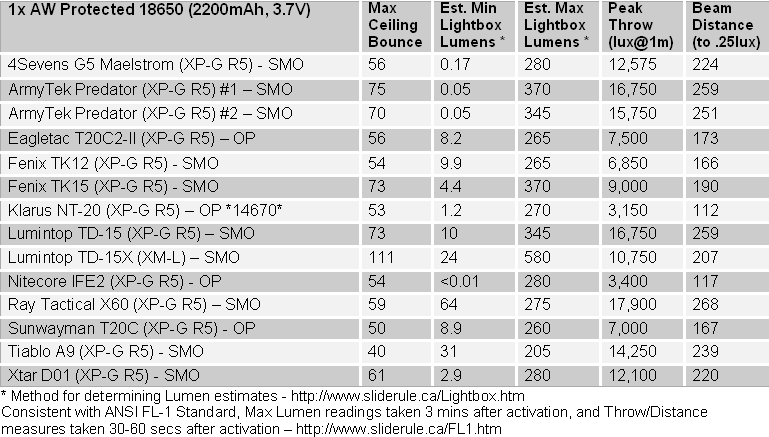
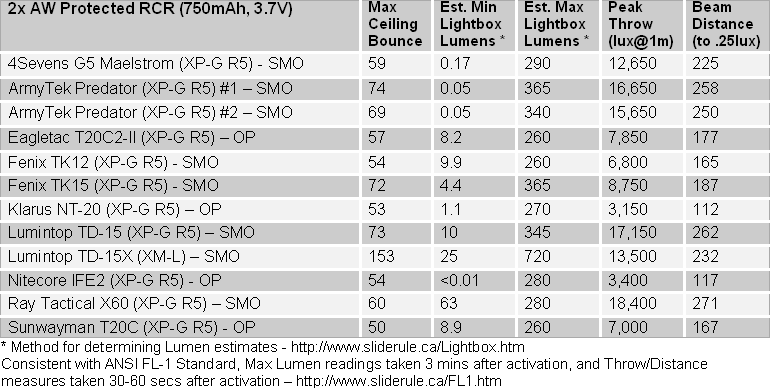
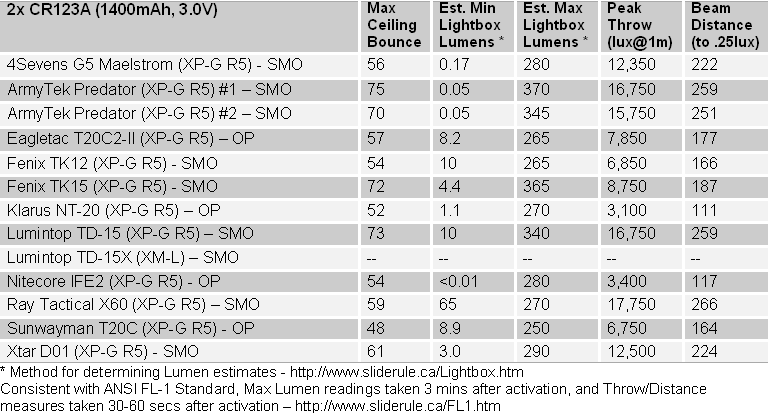
The max output and throw of the IFE2 are quite reasonable and consistent with its emitter and reflector design. The lowest output mode is incredibly dim - I can't accurately measure it in my lightbox. Simply put, you can stare into the illuminated emitter quite comfortably at the lowest levels. :thumbsup:
Output/Runtime Comparison:
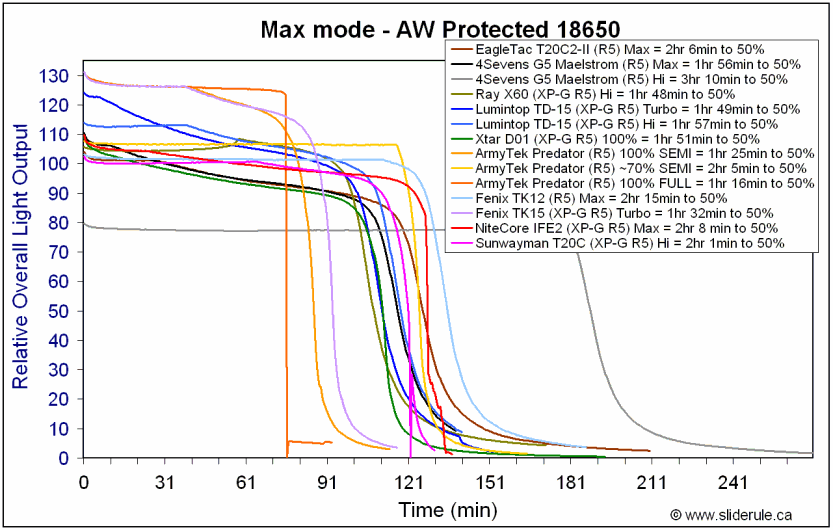
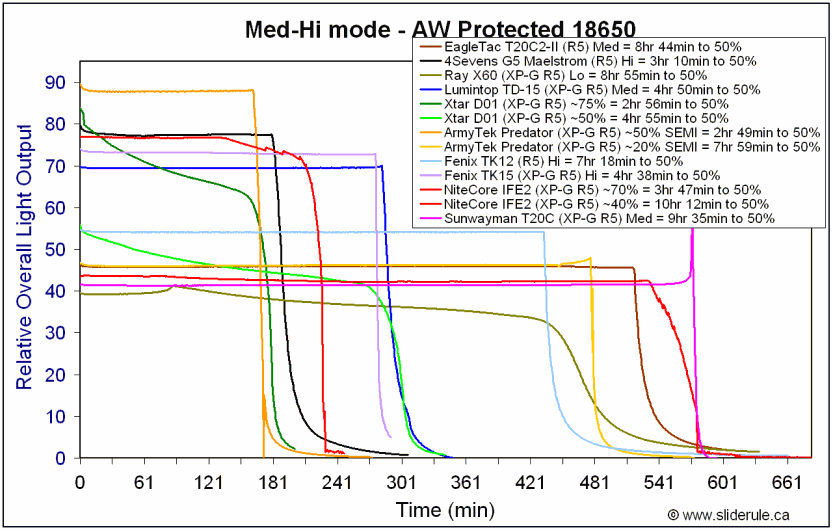
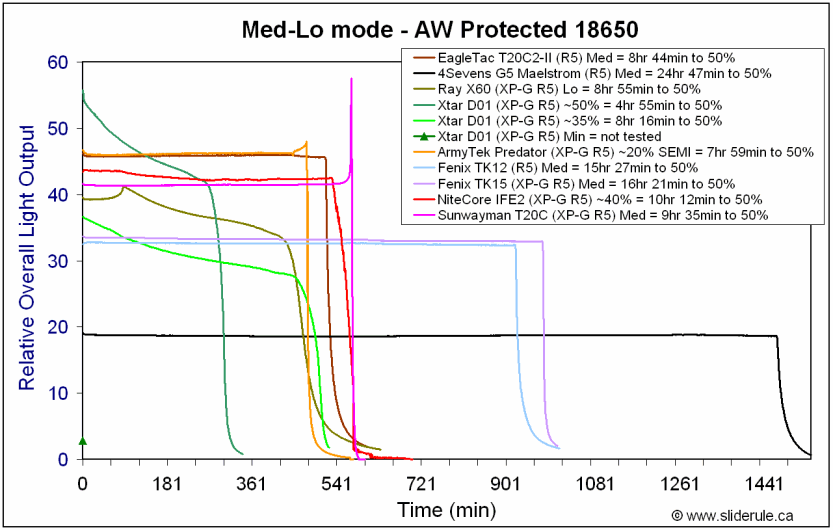
Note that although the specs do not mention 3.7V RCR, I found no issue with running my sample on 2xRCR. Of course, I presume that RCR is not officially supported, so you may run into a warranty problem if you encounter any issues.
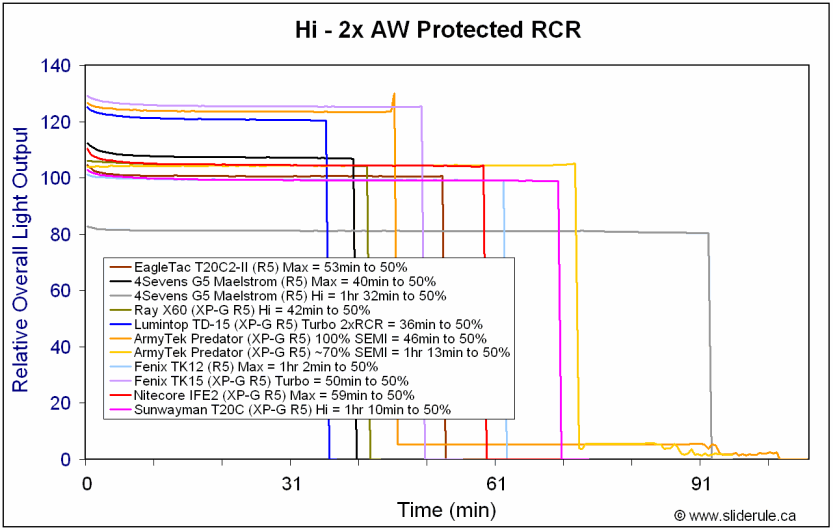
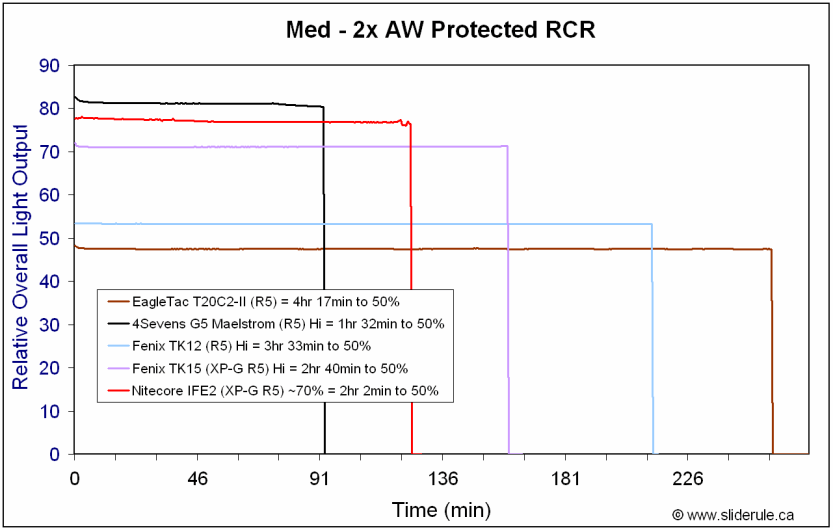
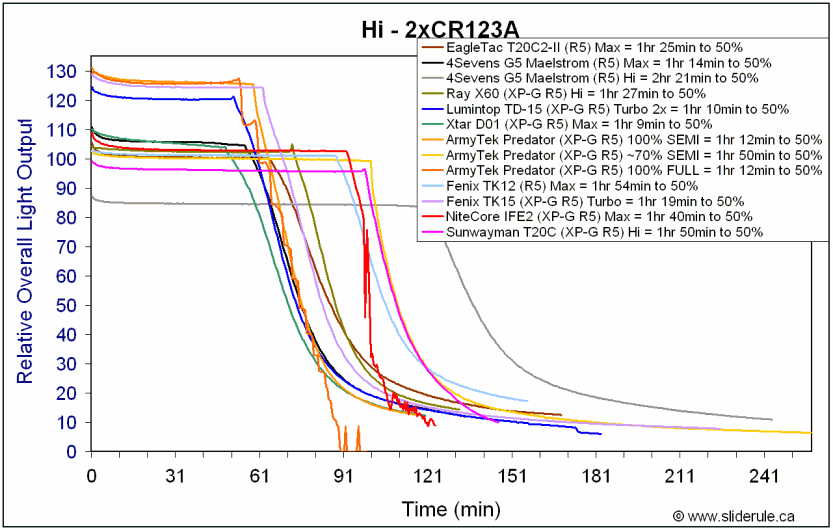
Overall efficiency seems quite good across the range of levels tested, considering the continuously-variable interface and (presumed high frequency) PWM-control. Of course, a current-controlled light with a limited number of defined (and optimized) output levels would be expected to outperform at comparable outputs. But this is a very good result for a continuously-variable light.
Potential Issues
Flat-top and some high-capacity button-top 18650 cells may not fit in the light. Standard protected 18650 fit fine, though.
Clip is pretty flimsy, and doesn't inspire a lot of confidence.
The "hidden" SOS mode is activated by rapidly cycling from bright-low-bright-low. However, in practice I found it a little too easy to accidentally activate it (i.e. you don't need to do it too quickly, or over too wide a range of outputs).
Preliminary Observations
The IFE2 is a very nicely designed light - I quite like the build and user interface.
Certain aspects of this light seem like classic Nitecore to me, while others seem to have been brought over from other makers. I should point out that JetBeam and Nitecore are now owned by the same parent company, which may explain some of the "cross-talk" I've seen on recent models for both companies. In this case, I suspect Sunwayman is also involved with the circuit design somehow, given the close similarity in performance to the V10A I reviewed recently.
To start with the build, I personally quite like the minimalist size and style. Hand-feel is good, and the light is surprisingly light and easy to pocket. Pocket-clip is pretty basic though, and the switch feels a little light-weight. Be aware, this is not a beefy light.
I can believe the 0.003 lumen low level spec for the IFE2 – this light has probably the lowest low I've ever seen. oo: And the dynamic range of the continuously-variable control ring is excellent. While not consistently "visually-linear" in the classic sense, it is quite cleverly designed to allow you to access a very wide range of low outputs, and then quickly access a roughly visually-linear set of high outputs. This is only the second time I've seen this particularly useful pattern (see my Sunwayman V10A review for a comparison).
oo: And the dynamic range of the continuously-variable control ring is excellent. While not consistently "visually-linear" in the classic sense, it is quite cleverly designed to allow you to access a very wide range of low outputs, and then quickly access a roughly visually-linear set of high outputs. This is only the second time I've seen this particularly useful pattern (see my Sunwayman V10A review for a comparison).
IMO, one advantage the IFE2 has over the V10A is a much wider traverse of the control ring (~2/3 the circumference of the light in this case). Coupled with knurling on the ring for enhanced grip, it's even easier to select the output mode you want here. The IFE2 has a standby detent below the lowest level, and strobe mode "hidden" on the other side of it. :thumbsup:
Like the V10A, I like the lack of detectable PWM on the IFE2 (rare on a continuously-variable light). Output/runtime efficiency seems very good across the range of outputs directly measured (again, surprisingly good for a continuously-variable light). However, the overhead on the circuit remains fairly high, and the estimated 1 week runtime on the lowest setting (or standby) seems believable.
FYI, Mrs seflbuilt is going to test this light out for me on her evening walking group walks. My preliminary impression is that the beam pattern and continuously-variable control ring would do well for this purpose, but I will wait for the expect assessment.
UPDATE March 25, 2011: Having used the IFE2 on walks, I remain very impressed with the interface and the beam profile. That being said, I find the "hidden" SOS mode a little too easy to activate in practice, and the ring traverse is probably a bit longer than it needs to be (i.e. half the circumference of the light would probably be ideal for me). But these are minor quibbles - the IFE2 has performed very well.
----
IFE2 was provided by Nitecore for review.

Manufacturer's Reported Specifications:
- LED: Cree XP-G R5
- SmartRing II 'Infinitely Variable' digitally controlled brightness system- allows the user to preselect any output level or a tactical strobe mode.
- Max output: 345 lumens, Min output: 0.003 lumens
- Runtime: Min Output- 7 days, Max Output- 2 hours
- Effective illumination distance: 133 meters
- Powered by 2 x CR123A or 1 x 18650 Battery
- Tailcap switch controls power on/off.
- Made from military grade T6061 aluminum alloy for unprecedented durability
- Mil-Spec type III Hard-Anodized scratch and corrosion resistant finish
- Anti-rolling rugged design
- Durable titanium alloy clip
- Waterproofing Standard: IPX-8 (waterproof for 1 hour at a depth of 2 meters)
- Dimensions: Bezel diameter- 0.92 in (23.4 mm), body diameter- 1.0 in (25.4 mm) with a total length of 4.96 in (126 mm)
- Weight: 2.2 oz (62.4 g)
- Package Contents: 1 x NiteCore Infilux IFE2, 1 x Lanyard, 1 x Spare rubber switch, 2 x Spare rubber o-rings, 1 x Instruction booklet
- Estimated street price: ~$130.


Packaging is fairly typical Nitecore. Inside the hard cardboard box with magnetic closing clasp is the light in cut-out foam, with a wrist strap, spare o-rings and boot cover, manual, and warranty card.


From left to right: CR123A, AW protected 18650, Nitecore IFE2, 4Sevens Quark 123-2, Klarus NT20, Eagletac P20C2-II, ITP SC2.
IFE2: Weight: 65.1g (no battery), Length 127.1mm x Width 23.6mm (bezel)
As you can see from the photo line-up, The IFE2 is quite small for this class of light. In fact, most of the other lights this small can't take protected 18650 cells (i.e. body diameter is too narrow). You are lucky if protected 17670 will fit – and often have to go down to 14670. I'm happy to report the IFE2 body takes all my protected 18650 cells. :thumbsup:
However, most of my recent high-capacity cells (even the button tops) wouldn't light up the IFE2. I believe this due to top of the cells not fitting into the head opening (which is slightly narrower than the body on my sample). Certainly, flat-tops or large button-tops won't work, as there is a raised disc around the positive contact surface in the head (see below).



Tailcap threads are anodized for lock out. The light cannot tailstand. Knurling is not overly aggressive, but the number of body elements helps with grip. Clip is fairly basic, and held on with Allen screws.
Anodizing is excellent on my sample, no chips in the dark gray natural finish (HA = type III). The color is a departure for Nitecore - it looks almost silver-gray. Lettering is sharp and bright.
Switch is a forward clicky, with a slightly longer than typical traverse.


The IFE2 features the Cree XP-G R5 Cool White. The reflector is textured to what I would consider a medium orange peel (MOP). The head opening is not very large, so I would not expect much throw from the IFE2.
Which brings us to the requisite white wall hunting
















As you can see, the IFE2 is definitely not a thrower. I found the beam to have a pleasant transition from hotspot to spill. Scroll down to my Summary Tables for more specifics on output and throw.
User Interface
Turn the light on by the tailcap switch. Half-press the tailcap for momentary-on, click for locked-on
Mode switching is controlled by the magnetic control ring in the head. The IFE2 features a continuously-variable interface – you control the output level by twisting the ring. You can select your desired mode while the light is off.
The ring traverses a little over 2/3 of the circumference of the light. There is one clear and firm detent just below the minimum output, which is a standby mode. Interestingly, strobe is "hidden" just below this detent (i.e. turn the ring a little past the detent to activate strobe).
Ramping Pattern
EDIT: this section has been updated and revised from my initial post.
The big question is whether the output selection of the IFE2 is "visually linear". Generally, here on the forums, that has been taken to mean a logarithmic ramp as opposed to an actual linear ramp of outputs. The reason for this is that we perceive brightness in a non-linear way (actually, not just brightness - most of our sensory perceptions are non-linear). This is why twice the lumens doesn't appear twice as bright to us - lumens are an objective (linear) measure of output, and our subjective perceptions are not linear.
A logarithmic adjustment has long been used to adjust for our relative visual perceptions (e.g. the stops of camera are logarithmic). And like most here, up until now I have found that all continuously-variable lights with a logarithmic correction of output generally look "visually-linear". And then the IFE2 (and Sunwayman V10A, which shares a similar circuit) came along.
To start, here is what the IFE2 looks like in my lightbox. To measure this, I slowly turned the ring at as close to a constant rate as I could manage, over ~40 secs or so. My lightbox collected output readings every second, and I then plotted the relative lightbox output against the estimated degree shift of the ring (i.e. with 360 degrees being a complete turn). Note the ring turns a little over 2/3 the circumference of the light, or about ~280 degrees.

I have blown-up the first third of the ramp in the inset graph, to show you that output does indeed increase over the whole ring (albeit seemingly slowly at first). Now, you can certainly argue that the output trace looks like it could be logarithmic. Indeed, if you plot it on a log scale, you get something approximating a straight line. However, the IFE2 does NOT subjectively appear to me to be visually-linear when handling (e.g. it does indeed spend a lot of time at the very low outputs over the first third of the ring).
Upon reviewing the scientific literature, I see that relative power relationships have superseded simple logarithmic corrections for linearizing our sensory perceptions. For perceived brightness, the currently accepted linearization method is actually a cube root of output. For a full discussion of this - including detailed graphs and primary literature references - please see post #3 in my V10A review.
When plotting with a cube root transformation of my lightbox's output scale, you get the following graph:

This graph MUCH better matches what I see by eye for the IFE2, compared to a logarithmic plot. :thumbsup: I have added the LiteFlux LF5XT (on 14500) to the graph, as it does both a linear ramp and a logarithmic step pattern. The linear and logarithmic ramps of the LF5XT also pretty closely match my relative perceptions.
The point to the above is to show that the IFE2 goes to much lower outputs than any other linear or logarithmic continuously-variable light I've seen before. It also betters matches what I subjectively see across the whole range of outputs on these lights. So for now on, I will also include this type of plot (along with standard linear plots) for all the continuously-variable lights I review.
All that aside, I actually consider this dynamic range control of the IFE2 to be superior to a purely "visually-linear" ramp across the whole range. The logarithmic correction allows you to exquisitely fine-tune your low output selection. :thumbsup: And once you get into brighter outputs, the proportional increase seems quite linear.
Intrepid readers may notice that the IFE2 has almost exactly the same pattern and low level as the Sunwayman V10A which I have recently reviewed. Please see that thread for a greater discussion of the relative ramping patterns.
One additional feature of the IFE2 is the "hidden" SOS mode. To access, cycle the light rapidly from bright to low, to bright, and back to low. Turn off/on to restore regular constant output control.
Current Draw
You would hope that this wide range of low modes translates into a range of super-long runtimes. Unfortunately, the circuit overhead for this level of control is considerable, and Nitecore estimates only one week of runtime at the lowest level.
I have measured the battery current draw at both the standby detent and at the lowest output level, and get 11mA on 1x18650 in both cases. For a standard capacity 2200mAh 18650, that would translate into 8.3 days (consistent with Nitecore's 1-week estimate). On 2xRCR (750mAh capacity), I measured 5mA, which would translate into just under a week.
PWM
I presume the light uses PWM for the variable outputs, but I was unable to detect the frequency with my setup (which means it must be in the high kHz range). It is certainly not detectable visually. :thumbsup:
At the highest output levels (i.e. over the last quarter turn of the ring), I was able to detect a weak signal in the 1.7-1.8 kHz range. This seems to be some sort of circuit artefact – it definitely isn't the PWM freq, as you could easily spot those levels with an oscillating fan.
Once again, that is remarkably similar to what I noticed on the Sunwayman V10A.
Strobe

Measured at 12 Hz in my testing.
Testing Method:
All my output numbers are relative for my home-made light box setup, a la Quickbeam's flashlightreviews.com method. You can directly compare all my relative output values from different reviews - i.e. an output value of "10" in one graph is the same as "10" in another. All runtimes are done under a cooling fan, except for any extended run Lo/Min modes (i.e. >12 hours) which are done without cooling.
I have recently devised a method for converting my lightbox relative output values (ROV) to estimated Lumens. See my How to convert Selfbuilt's Lighbox values to Lumens thread for more info.
Throw/Output Summary Chart:
Effective November 2010, I have revised my summary tables to match with the current ANSI FL-1 standard for flashlight testing. Please see http://www.sliderule.ca/FL1.htm for a description of the terms used in these tables.



The max output and throw of the IFE2 are quite reasonable and consistent with its emitter and reflector design. The lowest output mode is incredibly dim - I can't accurately measure it in my lightbox. Simply put, you can stare into the illuminated emitter quite comfortably at the lowest levels. :thumbsup:
Output/Runtime Comparison:



Note that although the specs do not mention 3.7V RCR, I found no issue with running my sample on 2xRCR. Of course, I presume that RCR is not officially supported, so you may run into a warranty problem if you encounter any issues.



Overall efficiency seems quite good across the range of levels tested, considering the continuously-variable interface and (presumed high frequency) PWM-control. Of course, a current-controlled light with a limited number of defined (and optimized) output levels would be expected to outperform at comparable outputs. But this is a very good result for a continuously-variable light.
Potential Issues
Flat-top and some high-capacity button-top 18650 cells may not fit in the light. Standard protected 18650 fit fine, though.
Clip is pretty flimsy, and doesn't inspire a lot of confidence.
The "hidden" SOS mode is activated by rapidly cycling from bright-low-bright-low. However, in practice I found it a little too easy to accidentally activate it (i.e. you don't need to do it too quickly, or over too wide a range of outputs).
Preliminary Observations
The IFE2 is a very nicely designed light - I quite like the build and user interface.
Certain aspects of this light seem like classic Nitecore to me, while others seem to have been brought over from other makers. I should point out that JetBeam and Nitecore are now owned by the same parent company, which may explain some of the "cross-talk" I've seen on recent models for both companies. In this case, I suspect Sunwayman is also involved with the circuit design somehow, given the close similarity in performance to the V10A I reviewed recently.
To start with the build, I personally quite like the minimalist size and style. Hand-feel is good, and the light is surprisingly light and easy to pocket. Pocket-clip is pretty basic though, and the switch feels a little light-weight. Be aware, this is not a beefy light.
I can believe the 0.003 lumen low level spec for the IFE2 – this light has probably the lowest low I've ever seen.
IMO, one advantage the IFE2 has over the V10A is a much wider traverse of the control ring (~2/3 the circumference of the light in this case). Coupled with knurling on the ring for enhanced grip, it's even easier to select the output mode you want here. The IFE2 has a standby detent below the lowest level, and strobe mode "hidden" on the other side of it. :thumbsup:
Like the V10A, I like the lack of detectable PWM on the IFE2 (rare on a continuously-variable light). Output/runtime efficiency seems very good across the range of outputs directly measured (again, surprisingly good for a continuously-variable light). However, the overhead on the circuit remains fairly high, and the estimated 1 week runtime on the lowest setting (or standby) seems believable.
FYI, Mrs seflbuilt is going to test this light out for me on her evening walking group walks. My preliminary impression is that the beam pattern and continuously-variable control ring would do well for this purpose, but I will wait for the expect assessment.
UPDATE March 25, 2011: Having used the IFE2 on walks, I remain very impressed with the interface and the beam profile. That being said, I find the "hidden" SOS mode a little too easy to activate in practice, and the ring traverse is probably a bit longer than it needs to be (i.e. half the circumference of the light would probably be ideal for me). But these are minor quibbles - the IFE2 has performed very well.
----
IFE2 was provided by Nitecore for review.
Last edited:


 I also think I'll try switching the boot cap. Great suggestion!
I also think I'll try switching the boot cap. Great suggestion!